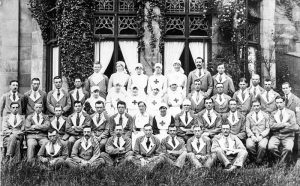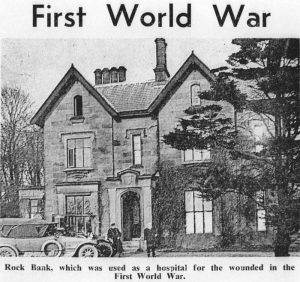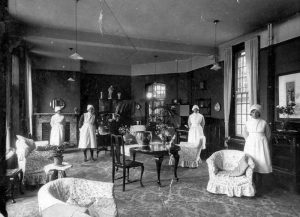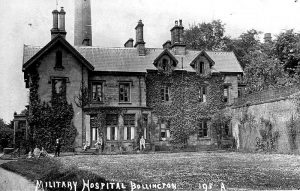 |
 |
A Victorian Gothic house built in Clarence Road adjacent to Clarence mill in about 1840 by Martin Swindells I, but he never lived in it, and he died in 1843.
T-shaped in plan, Ashlar buff sandstone, Welsh slate roof and five stone chimneys. 2½-storey, four-bay south front in Tudor Gothic style. With first and third bays stepping forward under gables.
During WWI and WW2 Rock Bank House was used as a recovery home for injured servicemen.
Today the house and it’s stable block are divided into apartments and rather incongruously, and regrettably, known as Carterbench House. The land behind the house, once part of the estate, contains the houses’ of Rock Bank Rise.
Census History
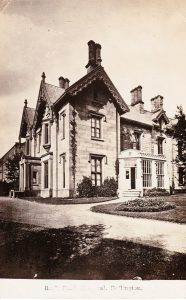
1851: Widower Martin Swindells II of the Swindells family, aged thirty seven years was resident. He lived with his son Martin, and twins(?) Frederick and Hannah aged six years. They had four servants one of which Martin later married. Her name was Charlotte Rowley and she was twenty six years old. Previously Martin had lived in Clough House, Ingersley Vale with his first wife Frances.
1861: Martin Swindells II was still at Rock Bank with his now wife Charlotte (was a servant on previous census) aged thirty six years. They had eight children.
1871: The Swindells were still living here but had by now got nine children, three more had been born since the last census, and some had left home.
1876: Rock Bank House was sold by Martin Swindells II to Fred Wilkinson a director of Brooke, Swindells and Co.
1891: George Cawley Swindells was the resident in this census, he was forty three years old and was a cotton spinner and doubler. He lived at Rock Bank with his wife Eleanor Maud née Hillier aged thirty eight years and their two children, Bernard aged three years, and Agatha aged one year. There was also a sick nurse and a cook.
1901: Alfred J King aged forty two years lived at Rock Bank House having previously lived next door at Limefield . He was an MP for the Knutsford division which included Bollington. His company A J King & Co. owned Ingersley Vale Mill. Alfred lived with his daughter Ida May aged eleven years and two sons John seven years old and Philip four years old. There were also four servants and a visitor on this day. Alfred is listed as married but his wife does not appear on this census. Alfred ‘lent’ Rock Bank House to be used as a hospital in WWI, see photos below. (Click on images to enlarge).
1911: John Reuben Price aged thirty years was a joiner and caretaker at Rock Bank House during this time. He was born in Bollington. His wife twenty nine year old Alice Mary was born in Warford near Knutsford. They had a two year old daughter named Alice Ruby who was born in Bollington.
1939: Richard Holt aged fifty eight years was a caretaker at a cotton mill. He lived with his wife Sarah who was sixty years old and described as a Housekeeper at the same mill as her husband.
1950s and 1960s: Rock Bank House was used by a company called Fine Spinners & Doublers testing yarn for Clarence Mill. Courtaulds later took over FS&D.
1960s and 1970s: Stockdale Engineering were at Rock Bank. They were filtration engineers, filtering particles of water waste from heavy industry. They had installed steel girders in one part of Rock Bank.
1970s: The following information was kindly provided by the then Chief Microbiologist and Biochemist Richard Vass who worked at Rock Bank Laboratories from 1973 to 1981. Note this was based in the Coach House which is the building at the top right on the old 1920`s aerial photograph, at the bend on the road of Beeston Brow.
1980s: The company Carterbench Advertising came from Poynton to Bollington in the early 1980s. It occupied Rock Bank House until it merged with Manchester based Brunnings. There was a subsidiary company Carterbench Product Development that designed toys. They separated and moved to Cheadle following the merger with Brunnings, and came back to Fernbank House on Tytherington Business Park in 1995, then finally to King Edward Street in Macclesfield in 2018. Notable toys they created in the 1980s were, ‘The Big Yellow Teapot’. There were close ties with Peter Pan, Bluebird and Kiddicraft during their time at Rock Bank. Some of their long term clients were Cheshire Building Society, The Isle Of Man Steam Packet Company, Holland’s Pies and Peter Pan. When they moved into Rock Bank the laboratories had been on the upper floor. Dragon TV rented the middle floor until they moved to what was once the Congregational Church (Churches) at the bottom of Beeston Brow, and Carterbench had the ground floor and later the upper floor until taking over the entire building. The basement had an art studio run by Dennis Gidion.
The long building at the back of Rock Bank House as seen on the aerial view below was used as a drawing office plus a workshop where prototype designs were made and tested, of what is not sure. And it was also used for Chemical research. This long building was knocked down in the 1980s and new houses built there which is now called Rock Bank Rise.
History has it that Rock Bank is haunted. One of the top rooms reverts to a Victorian nursery and the ghost of a nurse stands at the top of the stairs. There have been many sightings!
And in the 1980s it is believed there were old stone slabs in the cellar as it had been used as a morgue.
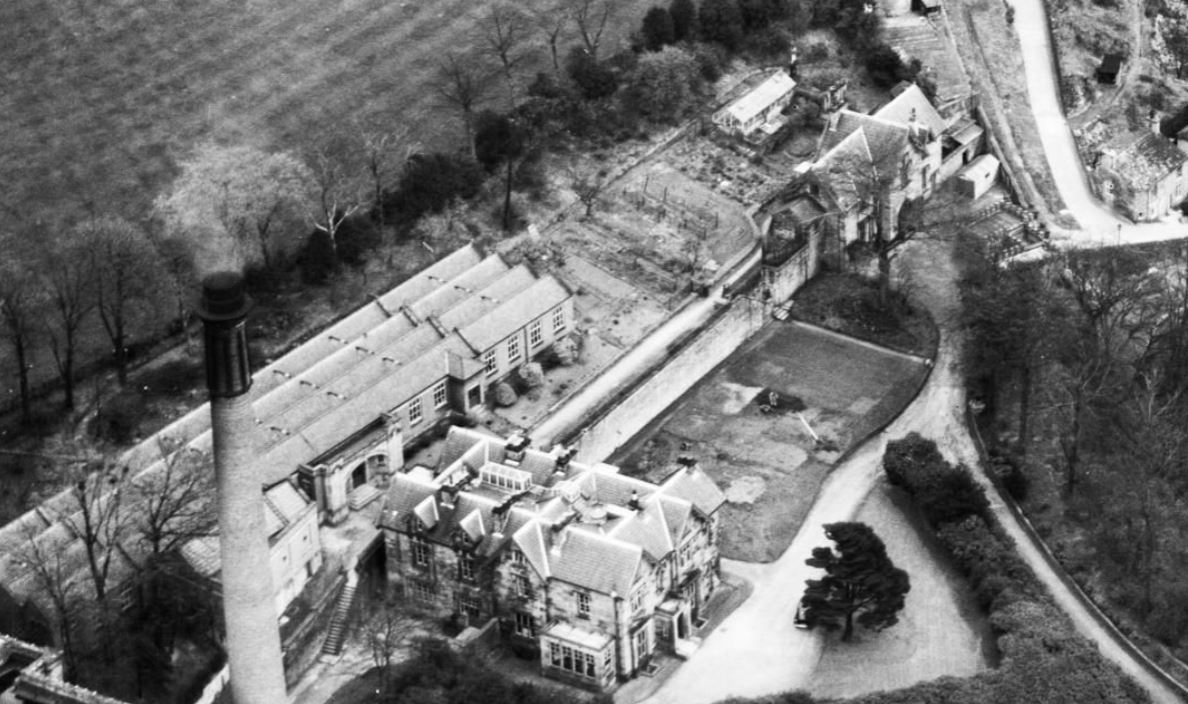
Above, an aerial view from around 1920. Rock Bank House in the foreground along with part of Clarence Mill chimney – history. The long buildings to the left are described above. At the top of the photo are the stables at The Coach House which is now a private house/apartments. There used to be an entrance to/from The Coach House from Beeston Brow on the bend. It is visible half way down on the right in the photo above. Evidence of this entrance is still there today. See photo below from 2018.
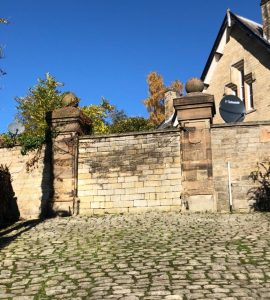
Listed structures
See Listed Buildings page for the full list and notes regarding Listed, Article 4, and SPD properties.
The links on the structures are to the Historic England web site. Any links to local history pages are to this web site.
 |
Rock Bank House |
Acknowledgements
Our thanks go specifically to Linda Stewart who has researched census and other information to present an interesting history of local people and properties.
Our thanks go to all those who researched and discovered the history that is presented in these pages. Please read the full acknowledgement of their remarkable achievement.
Acknowledgement also to Richard Vass for the information on the 1970s.
Your Historic Documents
Please don't chuck out those historic documents and pictures! Find out why here.
